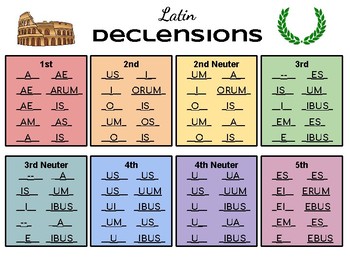


In this paper we present a case study of interpredictability in verbal inflection in Pitjantjatjara and Yankunytjatjara (Pama-Nyungan Australia).

Further typological work is required to investigate the ways in which inflectional interpredictability is achieved, and what aspects of wordforms may be informative. However, recent research shows that apparently complex inflectional paradigms can be organised in such a way that knowing one inflected form of a lexeme greatly reduces the uncertainty of other forms (e.g. Next time – a different approach to learning the same thing.Lexically stipulated suppletive allomorphy, such as that found in inflection class systems, makes wordforms unpredictable because any one of several exponents may be used to express some morphosyntactic property set. Aim to sit down for a few minutes at a time, five times a day for the coming week and see if you can do it (go on… you can… you know you can!).
Latin endings crack#
If you can transfer 25 words a day you’ll crack them all in a five day working week! And you’ll have produced some revision materials you can carry around with you to keep refreshing your learning over the coming weeks and months. You can tick each word in the book as you go to show you’ve transferred it. There are 122 possible rows of tables you could fill in if you transfer each Latin word from every box in every table on pp.13-20 of the Language Reference Book. You can even screen shot what you’ve done, crop the images, send them to a digital device, and then flip through them in the digital photo stream facility on that device!Įven better is a second, simplified version like this:Īnd producing the second simplified version from its first fully detailed form is in itself a learning process that makes you think about (and therefore remember better) what all the possible grammar of the endings could be. Following which you can print things, cut them out and stick them on index cards. It’s best to do it all (at least at the first attempt) in pencil if you’re going to do it by hand (and then go over it in pen or rub out each bit and replace it in pen). This is the sort of thing that fits nicely on a pocket-sized index card.

So you can make yourself a table like this: Ending “- a” That’s annoying and potentially very confusing! You’ll notice that the ending ‘- arum’ is always first declension, genitive case, plural number and almost always feminine gender, just very occasionally masculine gender.īut you’ll notice that the ending ‘- a’ can be first, second or third declension nominative, vocative, accusative or ablative case and feminine or neuter gender. You’ll need to refer to pp.13-20 of the Language Reference Book. One way to do this is by what I call ‘pattern spotting’. Here it’s helpful to have an overview of all that’s going on, combined with a strategy for honing in on the detail. What’s left to tackle now are the endings of words which put the grammatical terms and definitions into action. And you’ve now (hopefully) got all of that well underway, too (so keep that going, as well!). Just as you can learn the meaning of a word you can learn a technical grammatical definition. Just as you can learn the stem of a word you can learn a grammatical technical term. We’ve also established that grammatical terminology works just like vocabulary. We’ve well and truly established that memorising the basic meaning of words is all to do with their stems and that, in turn, is all to do with learning vocabulary which, by now, you’re thoroughly familiar (keep it going!). A276 – Learning Latin – Targeting Grammar – Tip 3


 0 kommentar(er)
0 kommentar(er)
